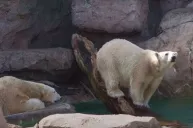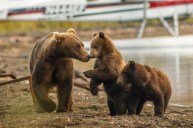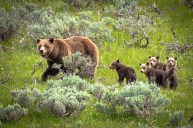Researchers completed the first-ever large-scale analysis of how often polar and grizzly bear hybrids live in the wild. They found that although possible, their existence is "extremely rare." According to the study, researchers explored the belief that the number of polar-grizzly hybrids has increased as the animals' habitats continue to overlap due to climate change, but could only confirm that eight "grolar bears" ever existed.
However, researchers say the study does more than dismiss speculation. Evan Richardson, an author of the study and a research scientist at Environment and Climate Change Canada, said through their findings, they've developed a new genomic toolset to rapidly detect hybrids. And they've also identified that hybridization is not a current conservation concern.
The new genomic toolset to identify grolar bears
For their research, scientists developed what they refer to as an "SNP" chip, which they use for genomic research. Using this chip, they will be able to rapidly identify grolar bears with 100% accuracy because they expect hybridization to increase as grizzly bears push northward into polar bear territories.
Dr. Joshua Miller, an assistant professor of biological science at MacEwan University, explained that the chip allows for "rapid and accurate consideration" of more than 8,000 genetic markers in polar bears. "This will allow for the assessment and monitoring of genetic diversity, which is a key part of a species' ability to survive changing environmental conditions," Miller said.
About those eight grolar bears
For the study, researchers examined genetic samples from 371 polar bears and 440 grizzly bears from three different areas collected between 1975 and 2015. Within that, they could only confirm eight hybrids.
Richardson explained that polar bears evolved from grizzly bears several hundred thousand years ago. "Although gene flow has occurred between the two species in the past, it appears that recent hybridization is restricted to a small group of polar bears and brown bears in the western Arctic," he said.
Referring to that research, researchers explained that hybridization is only possible in areas where grizzly and polar bear habitats overlap, so areas like the high Arctic are out of the question. Additionally, either species can father a hybrid (grolar when a grizzly is the father and a pizzly when a polar bear is the father).




